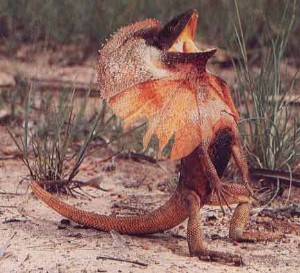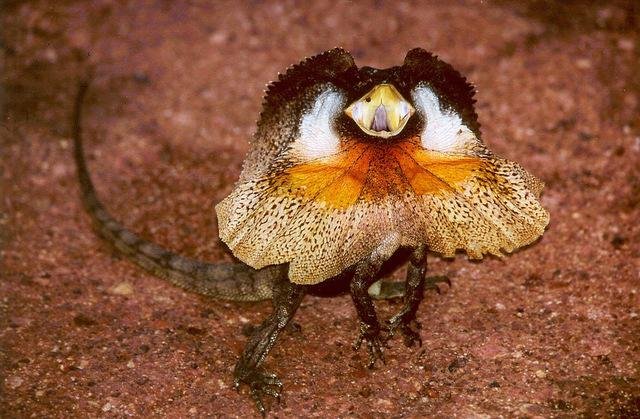Lizard with frills (Chlamydosaurus kingii)
The lizard with frills, sometimes called King's Clamidosaurio, due to its physical appearance. It is one of the most common types of lizards that people choose to have as pets. Before doing so, it is very important to learn everything you can about them and their needs.
This animal has a great ability to adapt to the environment. Australian scientists noted that he took advantage of the constant fires in northern Australia: after a fire, his stomach is able to house larger prey than he usually catches. While many of these reptiles die in fires, survivors prefer to stay in the devastated area to more easily get their food.
Their average life is 6 years. During the dry season they are in an almost inactive state; the temperature of your body decreases and that contributes to the need to feed. During the rainy season you spend more time on the ground eating insects or small vertebrates.

Habitat
The clamidosaurs are animals of arid earth and prefer a temperature of at least 32 degrees C * and support a temperature of 40 degrees without further complication and as for the night can be very comfortable with a temperature not less than 24 degrees C * its terrarium is recommended to manufacture it with glass to not stress too much and the minimum dimensions for a male is a terrarium no less than 1.20 meters long x 45 wide x 70 cm high preferably adorn with stones and pigmus under the terrarium a heating plate which day and night stay lit do not require much water so with a tank of about 10 cms is more than enough is essential that it is not too large because it can affect your ecosystem because the larger it contains more water and the heat evaporates the water and creates a very humid environment which is deadly for this species, we will need 3 types of spotlights one is ultra violet light for warm reptiles, another spotlight is light alog ene or daylight which depending on the size of the terrarium must be acquired either one of 75 wats or 100 wats (in occasions it will be necessary one of 125 wats if your terrarium is very large) and the last lamp is a light at night (moonlight) helps you maintain a certain temperature and emulates the color that radiates from the moon as they usually hunt at night, we will need some dry branches and trunks to set the terrarium a cover with grating to have a good ventilation of the terrarium .
Feeding
Insects and small vertebrates make up the bulk of the lizard's diet with frills. What you consume varies based on your location and the time of year. They are opportunistic lizards, and will eat almost anything that comes their way. In some parts of the year they consume large quantities of beetles and termites, in the rainy season they will feed on ants and termites.
The lizard with frills is an ambush predator. They will stay in the hidden trees, being careful to watch and listen to what is happening around them, then they will jump, with the element of surprise on their side, to get their prey quickly and without struggle.

Description
They have a large steering wheel around the neck, from which their name is derived. This feature around the neck is believed to help keep predators away, as they make them look larger than they really are.
When the lizard feels threatened the steering wheel opens and expands showing bright colors. This can give predators the feeling that they will be attacked, so they will keep the distance. These lizards use their two hind legs as means of locomotion in trees.
Distribution
Australia and New Guinea are the main places where the lizard with frills is found. They tend to thrive in humid climates, where they can cool off when needed and take sunlight to warm up. They can be difficult to find, since they tend to mix very well with trees.
Behavior
Most of the life of the lizard with frills develops in the trees, where they are able to mix and stay away from several terrestrial predators. They are also able to find the shelter and food they need in the trees, so they have little reason to venture on the ground.

Reproduction
From September to October the food seems to be more abundant and it is also when the mating takes place. The males can be very aggressive to each other, and they bite each other to have access to the mature female for mating. The females emit a strong smell that gathers the males around them.
After mating with a male and will have nothing to do with him, immediately the latter will go looking for another female to mate before the end of the season. They will put 8 to 23 eggs in their nests, the female must find a place to deposit them, it must be a safe and warm place, or the eggs will not survive long enough for the young to hatch.
The eggs hatch after 2 or 3 months, the hotter the faster they will emerge. When the temperatures are too high only female lizards will be born, when they are mild, a mixture of males and females will be born.
Where King's Clamidosaurio live
King chlamydosaurus live exclusively in northern Australia and southern New Guinea. Their level of adaptation allows them to live in warm tropics and regions of great vegetation. King chlamydosaurus habitat is composed of subhumid and semi-arid zones, and its main characteristic in this sense is that they are mostly arboreal animals, since they spend much of their time in the branches and trunks of trees, where they can camouflage themselves with the environment. It is known that King's clamidosaurus seldom descends to the ground, except perhaps in the rainy season or during the reproduction stage.
Curiosities of King's clamidosaurus
Despite its imposing appearance, King's clamidosaurus is completely harmless to humans
King's clamidosaurus is a very clever animal. When a person approaches him, he will usually move to the opposite end of the tree where he is, repeating this process over and over again to protect himself.
90% of the time, King's chlamydosaurs remain in the trees.
Like the vast majority of chameleons, these lizards can change the color of their body according to the environment.
The collar so characteristic of King's clamidosaurus is not only used to ward off predators, but also during mating, regulating body temperature.
When he feels intimidated, this lizard not only deploys his impressive collar, but also raises his front limbs and opens his mouth to emit a very peculiar whistle. If you can not get the predator away, you will run to the nearest tree to protect yourself.
It has been proven that King's clamidosaurus can adopt a bipedal position when running at high speed.
The ambient temperature of the nest is what defines the sex of the new chrysoaurs: when it is above 35 degrees Celsius, males will be obtained, while a lower temperature corresponds to the females.
From the moment they are born, the offspring of this lizard are able to unfold their so peculiar necklace.
Until 1991, the Australian coins showed an image of King's chlamydosaur as a national symbol.
In captivity, these lizards can reach up to 20 years of age.
I hope you like it
References for more information
https://en.wikipedia.org/wiki/Chlamydosaurus